With its savory filling, chewy and springy bun, and crispy panko coating, Japanese Curry Bread—or Kare Pan—is the star of pastries at Japanese bakery shops. If you are a fan of Japanese curry rice, you have to make this insanely delicious bread bun recipe at home.
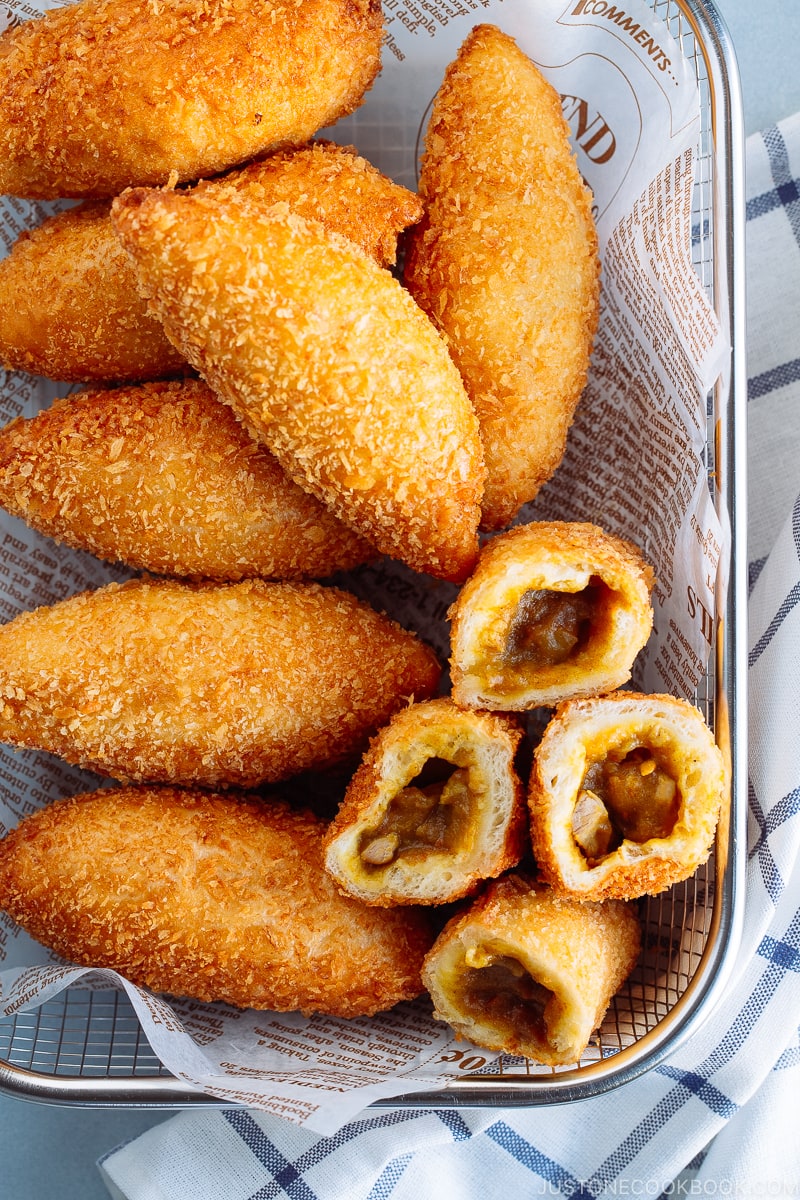
Kare Pan (カレーパン), or Japanese Curry Bread, is one of the most popular savory pastries at Japanese bakeries, along with Yakisoba Pan. There’s nothing more satisfactory than biting into a warm, crispy, and chewy bread that reveals mildly spiced Japanese curry inside, like a passageway to pure happiness. I know you’ll be obsessed with this homemade curry bread once you make it.
What is Curry Bread (Kare Pan)?
Curry bread (kare pan) is Japanese curry encased in bread dough, lightly covered in panko bread crumbs, and then deep-fried till golden brown. Justifiably qualified as comfort food, you can find these curry bread at bakeries and convenience stores throughout Japan. They are enjoyed for breakfast, lunch or snack, or any time of the day in my case.
Mr. JOC won’t leave a bakery shop in Japan without purchasing curry bread, and he’s always searching for the best one. I asked what is considered the best curry bread, and he said:
- The outside crust should be crispy when you bite into it.
- The bread should be chewy but not too thick.
- It shouldn’t be oily even though it’s been deep-fried.
- A good amount of curry should be filled throughout the bread.
As you can see, I have a tough customer at home. Since I welcomed a good challenge, I took it up as an encouragement to develop a good recipe!
There’s nothing fancy about the homemade curry bread. They are just downright tasty. Although it can be time-consuming, it’s totally worth the effort and time because you’d be rewarded with the tastiest bread. The triumph feeling is worth celebrating. I’d make this bread at least every quarter of the year!
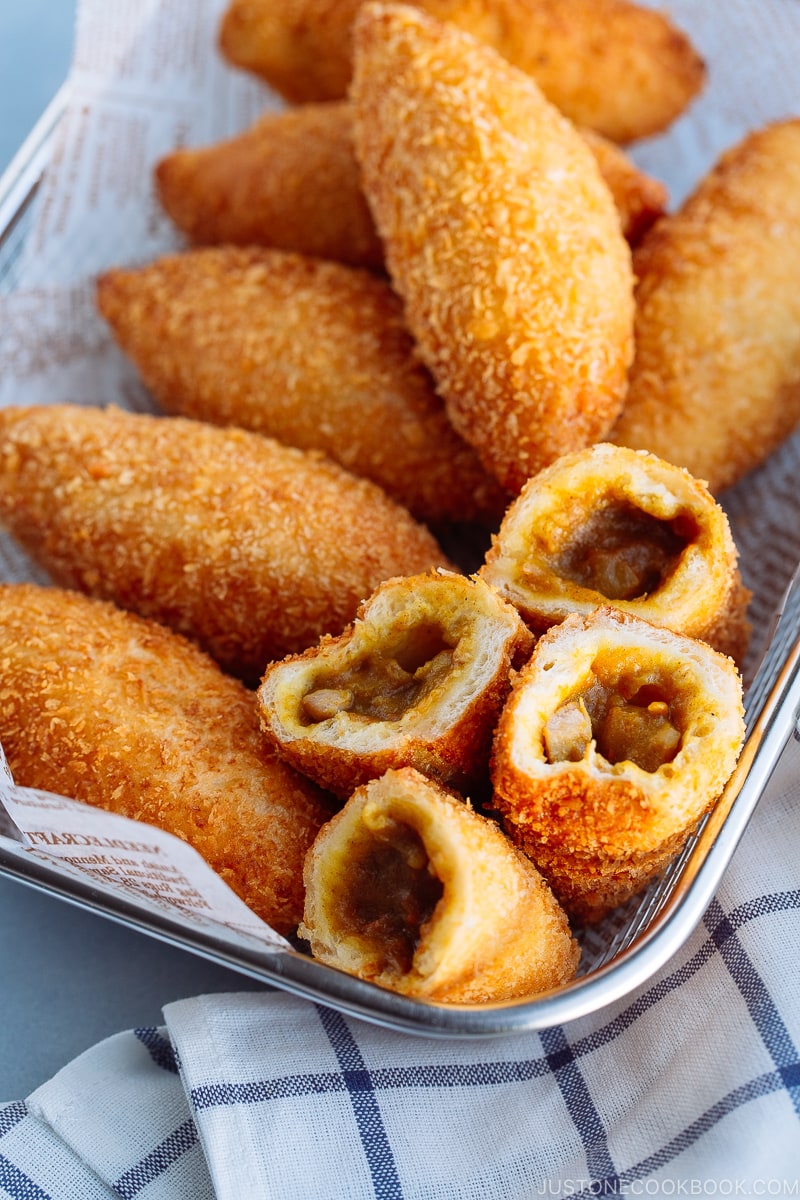
The Japanese Curry Filling
The best part about making your own curry bread at home is that you can stuff the bread with your favorite, delicious curry! Plus it’s the perfect way to use up one big batch of Japanese curry. You will only need about 1 1/2 cup worth of leftover curry. It has to be chilled, so leftover curry from the previous night makes the most sense for this recipe.
You can make Japanese curry with any ingredients you like. I used my Japanese Chicken Curry recipe for my curry bread. You can use other types of meats as well.
The curry next day should be in a thick paste form as you will be bundling up the curry filling in bread dough. Soupy curry is a no-no. Once you refrigerate your curry, it will solidify and easier to handle. Just take out the curry when you start making the bread, so it reaches room temperature by the time you fold it up in the dough.
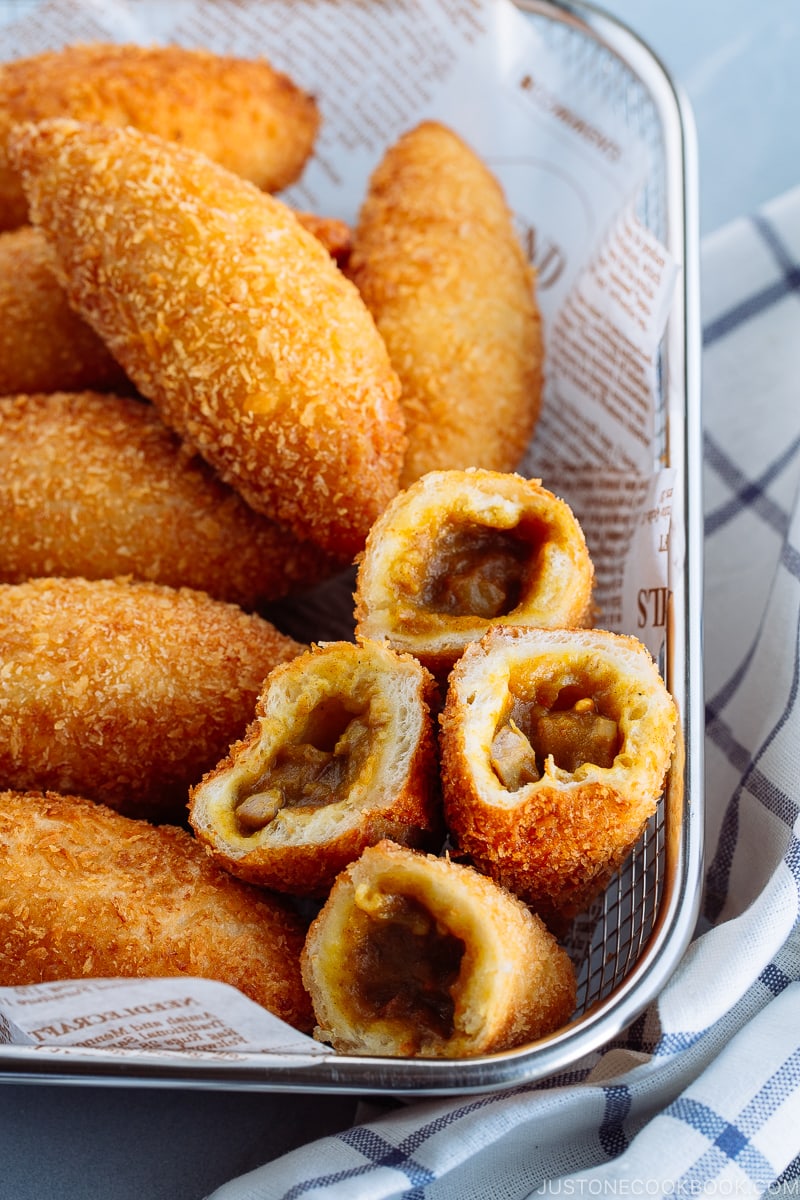
3 Important Cooking Tips
1. Thin out the dough only at the edge
I learned from my experience that I enjoy curry bread more when the dough has a chewy texture. Initially, I thought I prefer thinner bread because it has a nice crispy texture. But when I tasted the chewy and springy bread, I knew the whole curry bread experience got elevated.
To achieve this, it’s important not to roll out the dough too thin. The best way is to thin out only the edges of the round dough with fingers, keeping the center thicker. So when you fold and pinch the edges, the seam won’t be too thick and doughy, and the bread has even thickness throughout.
2. Do not overfill the curry paste
I’ve made this mistake and learned the hard way. When you place the curry filling on a round sheet of dough, make sure you have PLENTY of space around it so you can pinch the dough easily and tightly. You don’t want to overfill because if the curry touches the edge of the dough even a little bit, the pinched dough may pop open and the curry filling will fall out easily during the proofing and deep-frying stages.
If you accidentally made the mistake, here’s what you can do.
a) If the pinched dough is opened up before deep-frying, you can toast the panko first until golden brown, then bake the bread at 375 ºF (190 ºC). This is the same technique as my Baked Tonkatsu/Chicken Katsu recipes.
b) If the dough opened up during deep-frying, you want to immediately stop deep frying, instead gently remove the bread dough from the oil, pop them straight into the oven at 375 ºF (190 ºC) and bake until golden brown.
3. Flip the bread as soon as you place it in the oil
During the second proofing stage, the sealed side is on the bottom, and the dough is rising up. Now when you deep-fry, you will again place the sealed side down first. As deep-frying starts, the dough continues to rise from the bottom (seam side), and it tends to rise way too much, creating a cave inside the bread.
My high school friend Takafumi who used to work at a bakery in Japan shared a pro tip with me when I was struggling with this. He told me that you will need to flip the bread a couple of seconds after you place the dough in the oil, stopping the dough to rise in the same direction. This actually works magically! No more big cave in the bread!
Now that I’ve perfected my Kare Pan recipe, Mr. JOC no longer has to go out his way to hunt down the best curry bread because the best is always the homemade type. Are you ready for your Japanese curry bread mastery? Let’s get started!
More Fun and Delicious Snacks
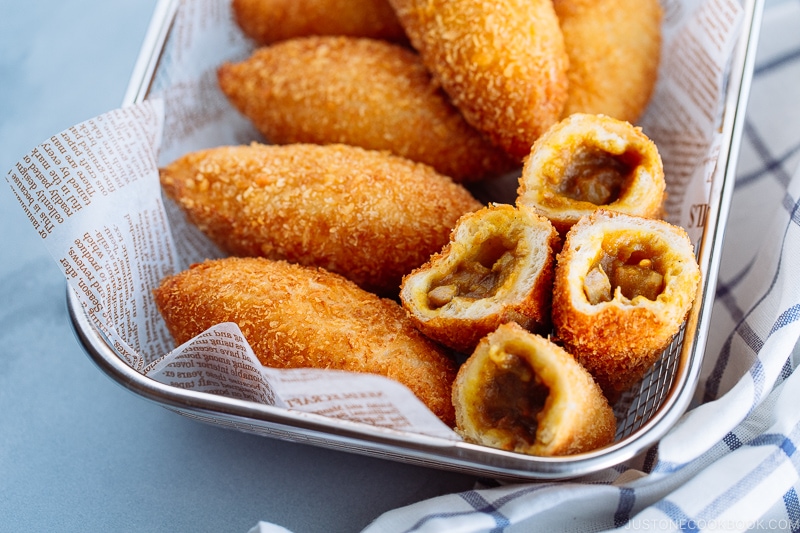
Wish to learn more about Japanese cooking? Sign up for our free newsletter to receive cooking tips & recipe updates! And stay in touch with me on Facebook, Pinterest, YouTube, and Instagram.
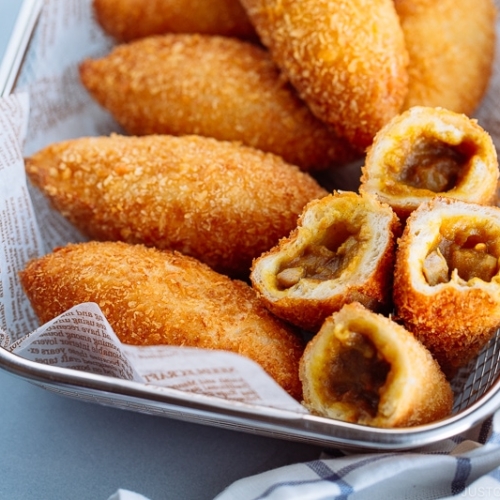
Curry Bread
Ingredients
- 1¼ cups bread flour (weigh your flour; for weights, click the Metric button; or use the “fluff and sprinkle“ method and level it off)
- 50 g cake flour (⅓ cup + 1 Tbsp; you can make cake flour at home)
- 1 tsp Diamond Crystal kosher salt
- 15 g sugar (1 Tbsp + ½ tsp)
- 125 ml whole milk (½ cup + 1 tsp; I highly recommend whole milk instead of nonfat or reduced-fat milk)
- 1 tsp instant yeast (to use active dry yeast, see Notes at the end of the recipe)
- 10 g unsalted butter (a bit less than 1 Tbsp (14 g); at room temperature)
- 1½ cups Japanese curry of your choice (at room temperature; made the day before and refrigerated overnight; aim for a solid, pasty texture; you can make my Beef Curry, Chicken Curry, or Instant Pot Curry recipes)
- 1 large egg (50 g each w/o shell) (for coating the bread with panko)
- 1 cup panko (Japanese breadcrumbs)
- 4 cups neutral oil
Instructions
- Gather all the ingredients. Leave the unsalted butter and Japanese curry at room temperature. I highly encourage you to weigh your ingredients using a kitchen scale for this recipe. For weights, click the Metric button above to convert the measurements to grams. If you‘re using a cup measurement, please follow the “fluff and sprinkle“ method: Fluff your flour with a spoon, sprinkle the flour into your measuring cup, and level it off. Otherwise, you may scoop more flour than you need.

To Mix the Dough Ingredients
- In a large bowl, whisk together 1¼ cups bread flour, 50 g cake flour, 1 tsp Diamond Crystal kosher salt, and 15 g sugar.

- Microwave 125 ml whole milk until warm to the touch, about 95ºF (35ºC). Then, add in 1 tsp instant yeast to the warm milk.

- Add the wet ingredients to the bowl with the flour mixture. Using a silicone spatula, combine together until it becomes a rough dough, about 1–2 minutes.

- Once the dough becomes a ball, add 10 g unsalted butter to the center of the dough and combine until the butter is well incorporated, about 2–3 minutes. At first, the dough will be sticky, wet, and oily and you might want to add more flour, but wait and try mixing it a little longer.

To Knead the Dough
- Once you don’t see any big chunks of butter, transfer the dough to a lightly floured surface. Knead the dough until it becomes smooth and pliable, about 5 minutes. Read the tip on kneading below.

- Tip on kneading: Using the lower part of your palm, push out the dough. Then, roll back up as if you’re drawing the number “8” with your hand. Rotate the dough 90 degrees every time you finish drawing a figure 8.

- After drawing a figure 8 a few times, bang the dough onto the work surface and fold it over away from you. This helps develop the gluten (elasticity). Turn the dough 90 degrees and repeat drawing the number 8 again. Continue this process until the dough is smooth, supple, and silky.

- When the dough is moist, smooth, and pliable, form it into a ball. Place the seam side down on the working surface and twist the ball a few times to close the seam.

The First Rise (Bulk Fermentation)
- Place the dough back in the bowl, seam side down. Cover with plastic wrap. Let it rise at 100ºF (38ºC) for 60 minutes, or until doubled in size. I used the proof setting in my oven. Tip: See my Shokupan post for tips on creating a warm environment for your dough.

- To use the finger test, dust your finger with flour and poke the center of the dough. If the hole doesn’t close up, it’s ready to divide. If the dough closes up immediately, proof the dough a little longer and test again.

To Divide the Dough
- Transfer the dough to a lightly floured surface and gently punch/press it down.

- Fold the dough into thirds widthwise.

- Fold the dough into thirds lengthwise.

- Turn upside down so the seam is facing down. Twist the dough to form a nice ball shape.

- Weigh the dough on a kitchen scale and divide the number by 8. Roughly cut the dough into 8 pieces.

- Weigh each piece of dough and cut off any extra if it weighs more than you calculated.

- Add the extra dough to the smaller dough piece(s). Hide the extra dough in the center of the ball by pulling down the dough from the sides.

- Twist the dough to seal the seam on your hand. Place the dough balls on a baking sheet lined with a silicone baking mat or parchment paper. Cover with plastic wrap, and let rest for 15 minutes at room temperature.

To Roll Out the Dough
- Working on one dough ball at a time, place the dough seam side up and flatten it with your hand. Fold in thirds widthwise.

- Fold in thirds lengthwise, and then turn it upside down so the seam side is on the bottom.

- Flatten again, and flip so the seam side is up.

- With a rolling pin, roll it out into a 3½-inch (9-cm) circle. Repeat with the remaining dough balls.

- Cover with plastic wrap and let rest for 10 minutes. One by one, pick up the dough circles. Pinch the edges with your fingers to thin them out while leaving the center thicker, to about 4 inches (10 cm) in diameter.

To Shape the Curry Bread
- Working on one dough circle at a time, place it seam side up. Gather 1½ cups Japanese curry of your choice. Add 1 to 1½ Tbsp curry sauce to the center of the circle. Do not overfill. Remember, KEEP THE CURRY AWAY from the edges! It’s the most crucial part. If you didn’t read my blog post, read tip #2 now in the post.

- Gather the opposing edges of the circle and fold the dough in half. Tightly pinch and press the edges to seal well so the seam does not open up during proofing and deep-frying.

- Next, to double secure the seam, fold the edges over to one side at least once, like folding a brown paper lunch bag. Press the edges again to secure.

- Place the bread, seam side down, back onto the tray with the silicone mat. Cover with a damp towel while working on the rest of the dough.

- Once you‘ve formed all the curry bread, crack 1 large egg (50 g each w/o shell) into a bowl and whisk well. Place 1 cup panko (Japanese breadcrumbs) in a shallow bowl/tray. Using a pastry brush, coat them with beaten egg and then panko.

The Final Rise (Proofing)
- Cover the bread with plastic wrap and let rise at 100ºF (38ºC) until 1½ times its size, for 45–60 minutes (I used the proof setting in my oven). If you touch the dough with your finger and the indentation remains, it‘s ready.

To Deep-Fry the Bread
- If you‘re new to deep-frying, please read my post on how to deep-fry food at home for tips on safe and successful frying. In a deep-frying pot (I use a 2.75 QT Staub), heat 4 cups neutral oil to 320ºF (160ºC). Place 2–3 pieces of the curry bread into the oil, seam side down. After a few seconds, flip it over so the seam side is now up. You may need to hold it with a pair of tongs. Keep turning them while they deep-fry, until they cook to a golden brown, about 2–3 minutes. Drain the oil well and transfer to a wire rack or some paper towels to drain while it cools.

To Serve and Store
- Serve hot or at room temperature. Keep the leftovers in an airtight container and store in the refrigerator for 3 days or in the freezer for 3–4 weeks. To reheat, bake at 350ºF (177ºC) until warm inside.
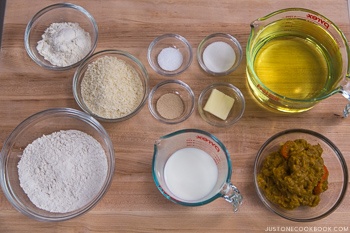

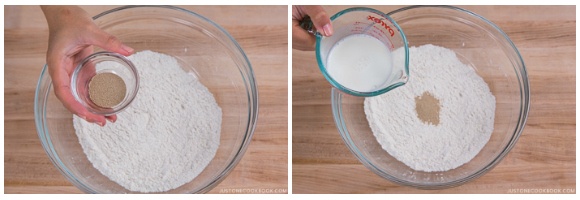


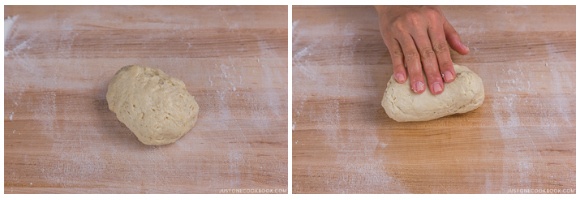

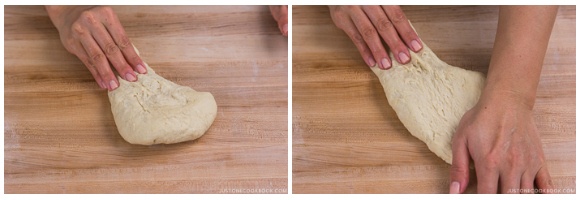
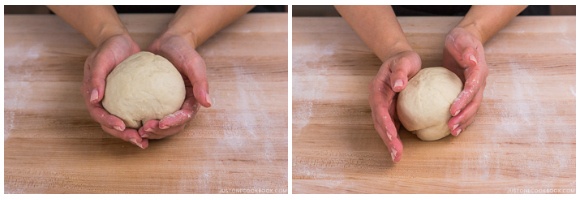
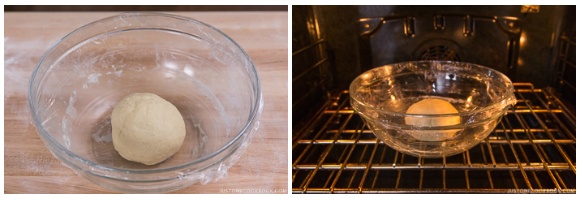

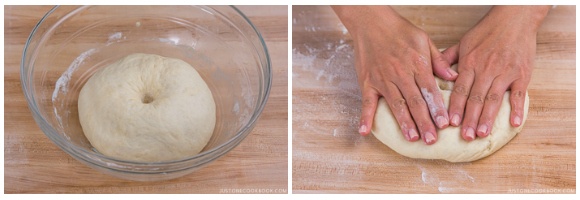
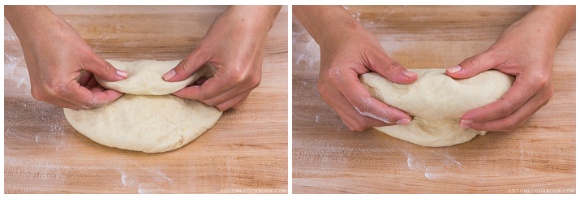
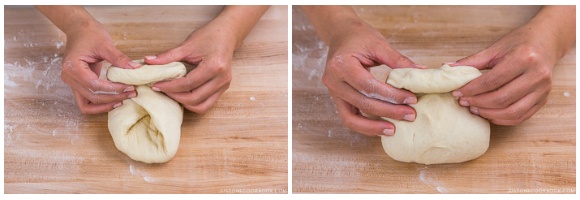
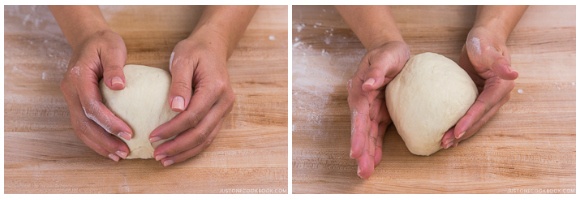


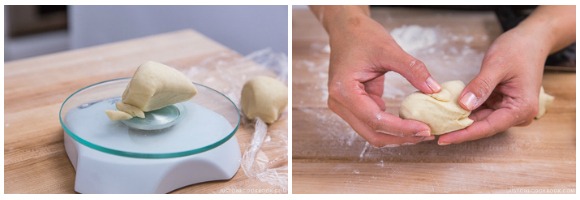
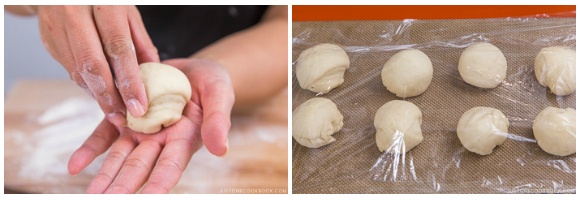


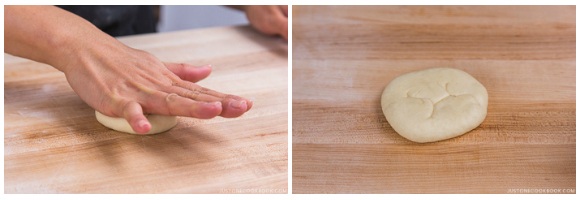
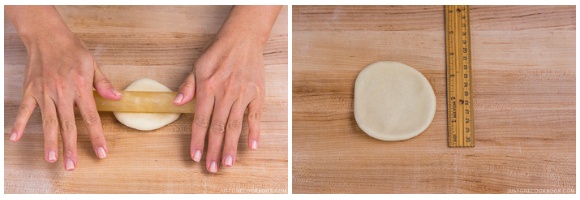
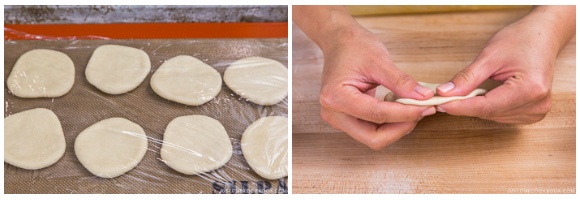
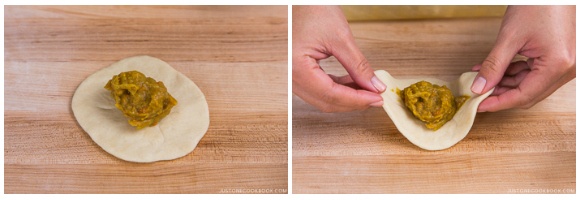
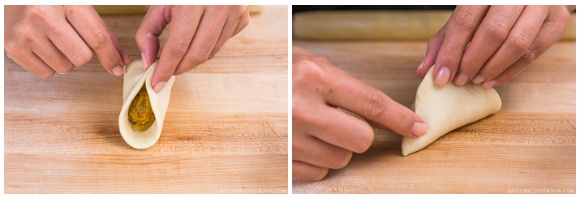
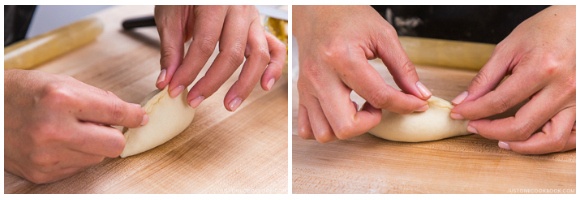
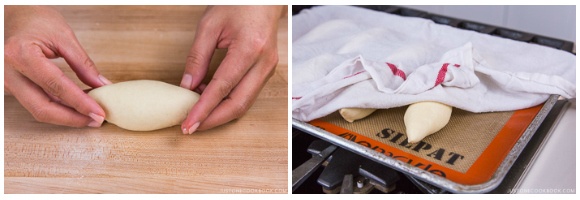
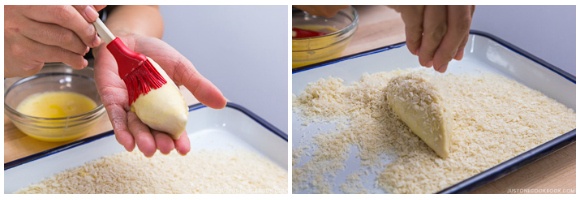
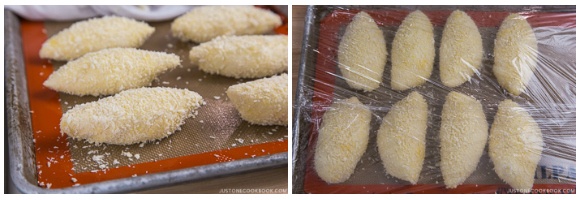
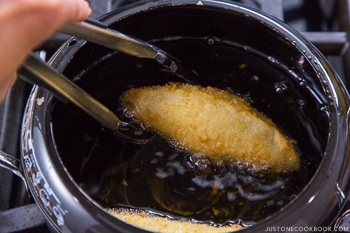










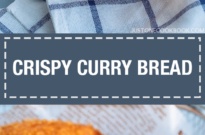
The recipe calls for butterni corporation too early. The dough cannot develop enough gluten later on. I couldn’t get a window pane no matter how much I was kneading. This caused problem when fillingthe dough with curry. The dough kept snapping back even after relaxing the dough. This made filling sufficient curry very difficult….
Hi Ping! Thank you for trying this recipe, and I’m sorry yours didn’t come out well. I’ve studied this recipe for a long time from different bread cookbooks and different online sources. Even though I would consider this is a rather advanced recipe, I think it’s do-able if you follow the steps precisely. I’ve seen many successful curry bread made by my readers on Instagram (#justonecookbook) and other social media, so I know it’ll work and I’m very confident that this recipe works. Please feel free to email me or ask me. I’d love to help.
I made these tonight, and they were amazing! I loved the bread dough – so soft and silky and light. It’s inspired me to make shako pan. Thank you for sharing this oishii dish!
Hi Jennifer! Thank you so much for trying this recipe! I’m so happy and excited to hear you tried this recipe. Thank you for your kind feedback. xo
Hello! I’ve been using your recipes for mostly sweets in the past but lately I’ve been trying your savory recipes too 🙂 I was planning to make this next week and I can’t wait! Everything I’ve made so far with your help has been absolutely delicious and loved by everyone I gave it to 🙂
However since this is my first time making a bread, I am a bit intimidated. I don’t have a proof setting on my oven, so I’m not sure how to approach letting it rise 🙁 can I just leave it at room temperature?(I live in socal and it’s been quite cold lately) Or put it in the oven without turning it on? Would I need to let it rise for a longer period of time?
Thank you so much for all your amazing recipes btw!!
Hi Tina! Thank you for trying my recipes! I’m glad you enjoyed them and thank you for your kind feedback.
Bread making is intimidated. Every time I am about to make bread, I need some extra power to get started, even though I know I’ll be rewarded with delicious homemade bread… it’s a time consuming process that “could” fail if something goes wrong…
I did not have a proof setting on my oven before getting this oven (p.s. It really helps – future consideration when your oven decides to retire). There are several hacks for this… sunny warm day helps (don’t put under direct sun), warm dryer (yes washer & dryer’s dryer), warm oven (keep it warmer for some time and turn off), what else I did… anywhere that’s warm… It’ll take a longer time if it’s not warm enough so you have to be patient. 🙂
Hope you will enjoy this recipe! It’s so delicious… be careful when wrapping curry… that’s one step you need to make 120% sure. 🙂
These are so dangerous…. dangerously moreish!
I just made these today and I have to say they were amazing. Light, crunchy on the outside, slightly chewy on the inside. It was a bit of work, but I actually made these on a weeknight. I had all the ingredients measured out the night before. My dough also rose a lot faster thanks to the weather (it’s summer in the Southern Hemisphere). This was the perfect recipe. They were beautiful. Thank you!
Some notes:
The breads were a bit hard to handle and coat/brush with egg since they’re pretty fragile!
I also noticed that they puffed up nicely during frying (I applied the tip of flipping them a few seconds into frying). During frying, there were times when the oil would spit a bit. Later on I saw that some of the curry breads had created a small hole to expel the hot air in the bread cavity during frying. No curry came out though, the hole was very small luckily. Maybe something to be weary of (especially if you’re afraid of frying like me)!
Hi Diana! Yay!! I’m so happy to hear you tried this recipe and enjoyed it! Yes… this is seriously dangerous and I can’t wait to make again (I think I had enough break from last time I made).
Thanks for sharing your notes. Yes, brushing with egg – it’s like handling a newborn… I think the dough split happens when it’s not closed / sealed tightly. And curry can seep through it. I’ve had that learning lesson on my first trial. It “can” be dangerous when curry comes out, so the sealing is SO important. And to seal tightly, the curry can’t be touched the edges… when curry touch the edge of the dough, the oil stays there and it won’t close tightly. That’s the main concern I have when I tried to explain this recipe… SUPER important part.
Thanks again for trying this recipe. You’ve made my day! xo
Thank you for posting this and giving standard measurements! My curry always ends up runny in spite of everything I do, but I think this technique will work beautifully with my tikka masala that always seems to solidify in spite of everything I do! I do have a question, though:
If you want to bake this instead of fry it, how long do you bake it at 350F?
Hi Kim! Filling is already cooked, so I’d say 400 ºF (200 ºC) for 15 mins? I’m not sure how panko will turn to golden color.
I may suggest using pre-toasted panko that I use for Baked Tonkatsu recipe.
https://www.justonecookbook.com/baked-tonkatsu/
This reminds me of the Malaysian curry puff but I think I will like this more, I like the milder Japanese curry 🙂
Hi Nami,
I made the Kare-pan yesterday and it turned out really well for my first time. This is one of my all-time favourite snacks – I think just as good as a hotdog or pie. This is quite a labour-intensive item to make, I was pretty exhausted afterwards but they were so good that I will still make them again. One note, I used Vermont Curry med-hot and it was a vegetarian curry. It was a really nice curry but I think for Kare-pan you need to use a curry with a bit more “deep-impact” as Japanese people say. Maybe S & B curry would be better because it has a bit more spice and flavour to kick through the bread.
Anyway, thank you so much for posting this recipe!
Hi Joe! Yay! Thank you for trying this recipe! Yeah, I agree, pretty labor intensive that I would only make maybe quarterly… not more than that for sure. I still remember the texture when you bite into it… oh soooo good!!!! I’m always S&B curry fan (just because it’s the first curry powder company in Japan. Haha). Thank you for the tip on Vermont Curry roux. Maybe you could add curry powder if that’s the only option at the local Japanese grocery store, too. Thank you again for your kind feedback!
I was wondering if you could bake them instead of frying them?
Hi Callie! Yes you can…. but if you put all the effort… I really would like you to try the deep fried version. It’s guilty pleasure, but so worth it. 😀
Oh Nami! Your curry pan look so good! I’m hoping to try your recipe very soon! Meanwhile, I’ll keep drooling at the pics……
Hi Donna! I was just telling Mr. JOC how much I miss eating this bread freshly deep fried…. and this was supposed to be Mr. JOC’s favorite, not mine! I hope you enjoy this recipe. It’s a lot of work, but at the end it’ll be worth it. Just be careful about keeping the edges of dough CURRY-FREE. 🙂
Hi,Nami! The curry bread looks soo good, can’t wait to try it! Also, I think there’s a chinese version of that it looks similar, with crispy but chewy bread outside and meat inside. There’s no curry in the chinese one though, which is just sad.😔
Hi Ashlynn! We love this curry bread although it takes so long to make it… the result is worthwhile when you get to enjoy the hot curry bread at the end! 🙂
What about freezing. Before or after deep frying?
Hi Sean! Should be after deep frying. 🙂
Hi Nami san,
So happy to have made this recipe w/ sourdough bread. It tasted so good after proofing overnight in the fridge that my son requested me to double the recipe to freeze so he can just thaw out as many as he wants to take to school. He usually just warm it up on nonstick pan until the oil came out and the outside crisp back up. He said by the time he ate it at school the fillings had come to room temp. Thank you so much for sharing.
Hi Ima! Your son is so lucky to bring this for his lunch! What a wonderful treat to enjoy during school…. 😀 Thank you for sharing your tip with us!
Hi Nami, my family loves curry buns too.
Juz wondering if the dough is doable by bread machine? Will it affect the result in any way?
Hi NJ! Yes, you can use the bread machine until you divide the dough. A lot of people use the bread machine to make it easy for the first part. 🙂
I love this recipe and would like to make a lot and stock it in the fridge. Can i freeze this for a week and take out some pieces whenever i want another one? Thanks in advance!
Hi Jenjen! Once you finish making, let cool and freeze. You can definitely do that. But since it’s fried food, I recommend consuming in a week (quality purpose) 🙂
Thank you Nami for this recipe. So excited about it as this is my favourite bread from the Japanese bakery near my office. Can’t wait to try the recipe soon. Thank you again!
Hi WT! Awesome! I’m so happy you want to try this recipe. Please read the post and instructions carefully (to avoid mistakes). And enjoy the bread. I wish I have one with me RIGHT NOW! SOOOOOOO GOOOOOD!
Hi< I just started making old World bread recipes. Ingredients are usually 4 to 6 not too different from yours. The big flavor enhancer is in the long processes. Have trouble proofing at a steady temp in my kitchen. A wonder of wonders I take my Nomiku (Immersion Circulator) in a dutch oven fit the mixing bowl in the water
& it holds an ideal at whatever temp you want. Life becomes simple.
Hi Tom! Haha, yes, Nomiku helps your dough rise too! 🙂 My oven has a proof setting, which helps A LOT. My old oven (which you probably see in my older posts) didn’t have one, so it was very hard to film/shoot recipes as waiting time can be longer… 😀
Hi Nami. Wonder if I can bake instead of frying. Would it come out similar? Not sure if you’ve tried.
Hi Luisa! It won’t be golden brown like deep-fried version so I still recommend deep frying, especially you spend so much time making this. You want the BEST curry bread at the end of your hard work.
I actually did this test before – dunk the curry bread in hot oil and pick it up immediately and baked. Spray oil doesn’t give you nice golden brown and it’s different, so I had to coat with the oil… but I realized that I should just deep fry if I have to this step. 🙂
Would it be possible to make this in an air fryer?
Hi Rebecca! I don’t own an air fryer… so I’m not too sure. 🙁 I think you can?? But not sure the temperature or time…
Hey Rebecca, if you haven’t tried using your air fryer yet, 7 minutes on each side at 375 degrees Fahrenheit worked for me, even without toasting the panko first. Hope this can work for you!
This looks great! I can’t wait to make it.
Where do you get the mesh tray you place the bread in? It looks great for fried products.
Hi Joan! Hope you enjoy this recipe. I really, REALLY enjoyed eating this curry bread! The mesh tray was from a Korean grocery store in Sunnyvale, CA. 😀 I bought them as they are perfect for draining my favorite food, Korokke. 🙂
Hi! Would it be possible to use all purpose flour instead of bread flour? Would cake flour still be necessary?
Hi Elisa! Typically you make bread with bread flour, and we make the perfect texture of bread (for curry pan) by mixing the two types. You can use other flours but the result won’t be the same (probably less bread-like with all-purpose flour). 🙂